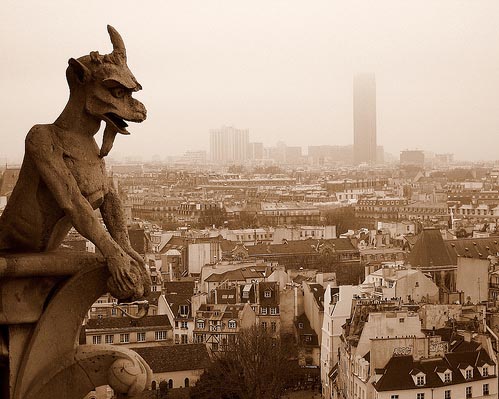|

|
The term originates from the French gargouille, originally "throat"
or "gullet"; cf. Latin gurgulio, gula, gargula ("gullet" or
"throat") and similar words derived from the root gar, "to swallow",
which represented the gurgling sound of water (e.g., Spanish garganta,
"throat"; Spanish gárgola, "gargoyle"). It is also connected to the
French verb gargariser, which means "to gargle." The Italian word
for gargoyle is doccione o gronda sporgente, an architecturally
precise phrase which means "protuding gutter." The German word for gargoyle is
Wasserspeier, which means "water spitter." The Dutch word for gargoyle is waterspuwer,
which means "water spitter" or "water vomiter." A building that has gargoyles on
it is "gargoyled."
A French legend that sprang up around the name of St. Romanus ("Romain") (AD 631–641), the
former chancellor of the Merovingian king Clotaire II who was made bishop of
Rouen, relates how he delivered the country around Rouen from a monster called Gargouille or Goji. La Gargouille is said
to have been the typical dragon with batlike wings, long neck, and sprouts fire
from its mouth. There are multiple versions of the story, either that St.
Romanus subdued the creature with a crucifix, or he captured the creature with
the help of the only volunteer, a condemned man. In each, the monster is lead
back to Rouen and burned, but its head and
neck would not, due to being tempered by its own fire breath. The head was then
mounted on the walls of the newly built church to scare off evil spirits, and
used for protection. In
commemoration of St. Romain the Archbishops of Rouen were granted the right to
set a prisoner free on the day that the reliquary of the saint was carried in procession.
The term gargoyle is most often applied to medieval work, but throughout all ages
some means of water diversion, when not conveyed in gutters, was adopted. In Ancient Egyptian
architecture, gargoyles showed little variation, typically in the form of a
lion's head. Similar lion-mouthed
water spouts were also seen on Greek temples, carved or modeled in the marble or terracotta cymatium of the cornice.
An excellent example of this are the 39 remaining lion-headed water spouts on
the Temple of Zeus.
There were originally 102 gargoyles or spouts, but due to the heavy weight (they
were crafted from marble), many have snapped off and had to be replaced.
Many medieval cathedrals included gargoyles and chimeras. The most famous
examples are those of Notre Dame de Paris. Although most have
grotesque features, the term gargoyle has come to include all types of images.
Some gargoyles were depicted as monks, or combinations of real animals and
people, many of which were humorous. Unusual animal mixtures, or chimeras, did
not act as rainspouts and are more properly called grotesques. They serve more
as ornamentation, but are now synonymous with gargoyles.
|
 Copyright(c) 2007
- 2020. All rights reserved. Copyright(c) 2007
- 2020. All rights reserved.
|

![]() Copyright(c) 2007
- 2020. All rights reserved.
Copyright(c) 2007
- 2020. All rights reserved.